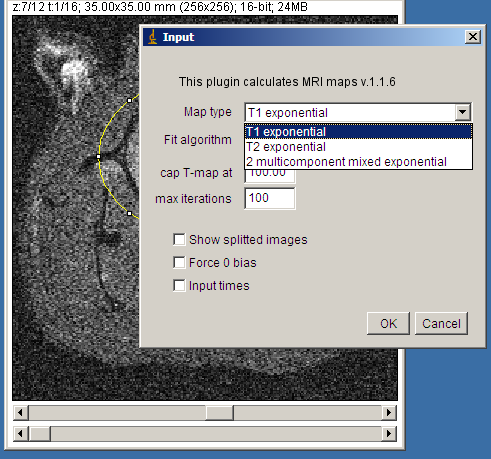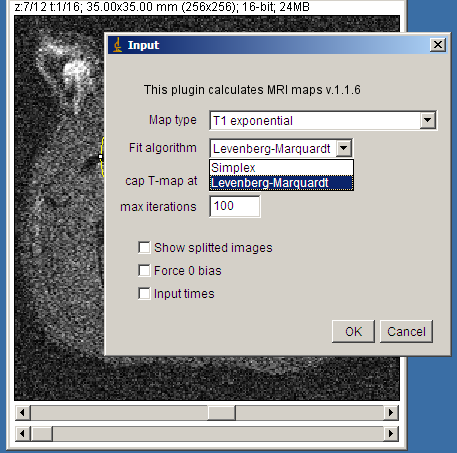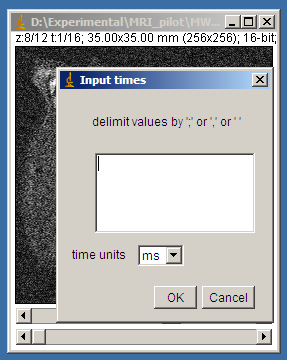−Table of Contents
MRI Processor
Introduction
This pluign calculates parametric maps in MR images. One important use of MRI is the possibility to use different mechanisms to distinguish different tissues and disease processes. The primary contrast mechanisms exploit relaxation of the magnetization. The two types of relaxations are termed spin-lattice relaxation, characterized by the relaxation time T1, and spin-spin relaxation, characterized by the relaxation time T2. T1 relaxation refers to the return of excited protons to the original energy state of the static magnetic field. Since this represents energy exchange between spinning high energy protons and the molecular lattice from which they were excited, it is also called spin-lattice relaxation.
Author
Dimiter Prodanov; (C) 2009
Features
- Calculation of T1 and T2 parametric maps.
The T2 maps functionality is being validated with the help of Mr Jesse Trekker, FNS group, IMEC, Dr. Simon A. Roussel, CI-NAPS, Univ. Paris Descartes, CNRS ; Dr. Tom Dresselaers and Prof. Uwe Himmelreich, MoSAIC, Katholieke Universiteit Leuven.
- Arbitrary closed ROI support
- Support of 4D data sets (volume + time)
- Integration with the ResultsTable
Description and Operation
The plugin is based in part on the old MRI_Analysis_Calculator by Karl Schmidt. I acknowledge the help of Ms Carole Ciliberti for the plugin debugging and testing.
The Input screen looks like this:
Currently the plugin supports 2 fitting algorithms:
- The Levenberg–Marquardt algorithm implemented by the LMA package
and the
- The general purpose Simplex algorithm based on the ImageJ implementation.
The user can select any of the two techniques:
The user can specify the number of iterations and can force the constant bias parameter to 0.
Next, the user can be asked to input the Echo/Repetition Times. The plugin recognizes the presence of such entries in the Results table. In case no times are input the plugin assumes default values (debug purposes).
Installation
Download and copy the three jar files into the plugins directory of ImageJ.
Download
You need to download all three jar files. By downloading and using these jar files you agree with the explicit and implied terms of use and redistribution stated in section Licenses or in the pages pointed by the links therein:
Disclaimer
This library is distributed in the hope that it will be useful, but WITHOUT ANY WARRANTY; without even the implied warranty of MERCHANTABILITY or FITNESS FOR A PARTICULAR PURPOSE. See the GNU Lesser General Public License for more details.
In particular, the author disclaims any particular fitness for medical diagnostic purposes.
Licenses
MRI Processor is distributed under GNU General Public License. This library is free software; you can redistribute it and/or modify it under the terms of the GNU Lesser General Public License as published by the Free Software Foundation; either version 2.1 of the License, or (at your option) any later version (See full text).
You should have received a copy of the GNU Lesser General Public License along with this library; if not, write to the Free Software Foundation, Inc., 59 Temple Place, Suite 330, Boston, MA 02111-1307 USA.
JAMA is released in the public domain: See here.
LMA was developed by Janne Holopainen: See his homepage.
Version history
1.1.6 22 Jan 2009
- bug fix: integration with BrukerToolbox
- added possibility to force bias to 0; user request by Simon Roussel
1.1.5 19 Dec 2009
- added support for variable number of iterations
- bug fixes
1.1 19 Nov 2009
- added support of arbitrary closed Rois
1.0.5 16 Nov 2009
1.0 03 Nov 2009
Known Bugs
Let me know and I will fix them ;)



